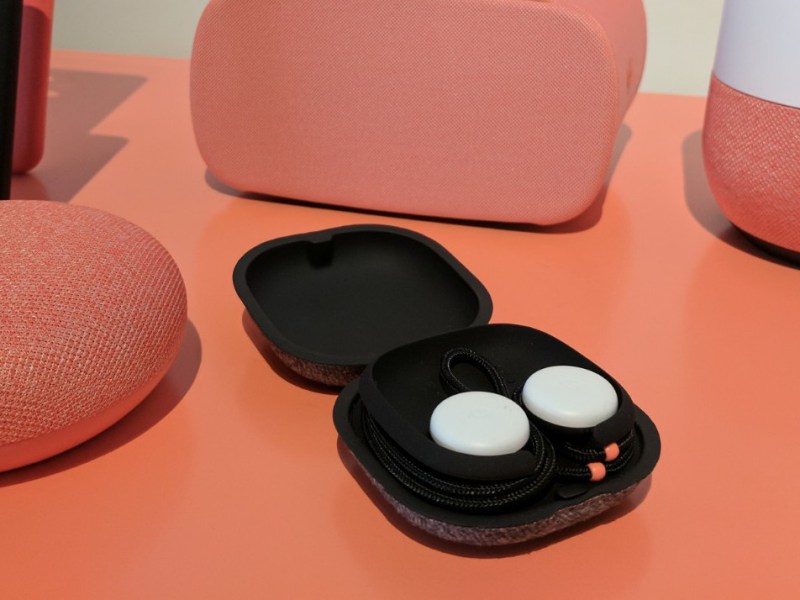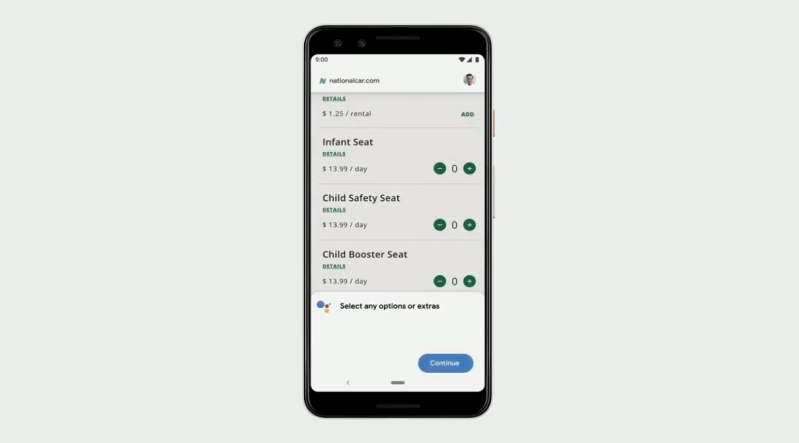testsetset
On October 15 at 10 a.m. Eastern (7 a.m. Pacific), Google will kick off its third annual “Made by Google” hardware event. For the second year in a row, the Mountain View company is hosting a press conference in New York City rather than San Francisco. But unlike last year, the event is expected to offer very little in the way of surprises.
A veritable flood of leaks over the past few months has painted a fairly extensive picture of what to expect. New flagship smartphones in Google’s Pixel lineup — the Pixel 4 and Pixel 4 XL — are a given. (Google has confirmed as much.) We’ll likely see Nest-branded, Google Assistant-powered smart speaker with a wall mount, perhaps alongside a successor to Google’s mesh networking hardware for homes (Google Wi-Fi). An upgraded Pixelbook is a shoo-in, as is a refresh of Google’s Pixel Buds. And there’s a slim chance we’ll see Google’s long-rumored smartwatch reference device, the Pixel Watch.
Pixel 4 and Pixel 4 XL
It’s not a stretch to say there’s almost nothing we don’t know about the Pixel 4 and Pixel 4 XL, given all that has leaked. Several hands-on videos have been published in the past two months alone, revealing all three of the forthcoming phones’ colors and their prominent rear cameras. Google itself revealed two headliners in facial recognition and gesture detection, the latter of which is likely based on the tech giant’s Project Soli technology (which uses radar to detect hand and finger movement).
So what else is new with the Pixel 4 and 4 XL? Goovigle’s next flagships reportedly feature unibody designs with large top bezels, square rear camera modules, and jet-black frames. The Verge reports that the cover glass and outer band have a textured finish designed to resist fingerprints and sweat. And while the Pixel 3’s rear-mounted Pixel Imprint sensors appear to be missing in action, that’s presumably because they’re embedded beneath the screen à la Samsung’s Galaxy Note 10.
June 5th: The AI Audit in NYC
Join us next week in NYC to engage with top executive leaders, delving into strategies for auditing AI models to ensure fairness, optimal performance, and ethical compliance across diverse organizations. Secure your attendance for this exclusive invite-only event.
Under the hood, the Pixel 4 and Pixel 4 XL are said to sport Qualcomm’s Snapdragon 855 system-on-chip paired and a proprietary coprocessor — the Pixel Neural Core, successor to the Pixel 3’s Visual Core — for photo pre- and post-processing. (For point of reference, that’s the same Snapdragon chip inside the OnePlus 7 Pro, ZTE Axon 10 Pro, and LG G8 ThinQ.) They’re complemented by 6GB of RAM and up to 128GB of storage and either a 2,800mAh (Pixel 4) or 3,700mAh battery (Pixel 4 XL). Elsewhere, the Pixel 4 and 4 XL are anticipated to pack screens with ultra-smooth 90Hz refresh rates, much like those on the OnePlus 7 and OnePlus 7T. And if rumors are to be believed, at least one of the new Pixels phones’ dual rear-facing cameras will be capable of up to 8 times digital zoom
That’s all compelling stuff, but the new Pixels’ software might be just as (if not more) impressive than their hardware. A redesigned and on-device Google Assistant experience is in tow, Google says, and it’s up to 10 times faster than Assistant on the Pixel 3. A beefed-up camera app supports a new astrophotography mode that enhances the brightness and contrast of night-sky images. As for the aforementioned gesture recognition, dubbed Motion Sense, it’s said to be compatible with a raft of third-party apps, including Amazon Music, Apple Music, Deezer, and Spotify, plus a new Pokémon-themed minigame called Pokémon Wave Hello.
There’s plenty more where those leaks came from, but that’s the 30,000-foot-view. Pricing remains a mystery, but it’s a safe bet that neither will be much more expensive than the $799 Pixel 3 and $899 Pixel 3 XL. Of course, if a rumored but by no means confirmed 5G-compatible Pixel 4 model were to be unveiled alongside the Pixel 4 and Pixel 4 XL, it would probably command a premium.
Pixelbook Go
It’s been two years since the debut of Google’s Pixelbook, a powerful 2-in-1 designed to showcase the best of Chrome OS. Last year saw the launch of the Pixel Slate, a Chrome OS tablet with a magnetically detachable keyboard, but rumblings suggest Google is returning to its long-in-the-tooth clamshell lineup this year.
The Pixelbook’s successor — which is reportedly called the Pixelbook Go, code-named Atlas — might boast a lightweight magnesium alloy exterior and a 13.3-inch touchscreen display (with a 16:9 aspect ratio) and a resolution from 1080p up to 4K, depending on the configuration. It’ll nix compatibility with Google’s Pixel Pen stylus, unfortunately. But as something of a consolation, the Pixelbook Go is likely to come in Intel Core m3, i5, or i7 flavors paired with 8GB or 16GB of RAM and 64GB, 128GB, or 256GB of storage, with improved front-firing speakers and dual microphones in tow.

Among the Pixelbook Go’s other spotlight features are a 2-megapixel front-facing camera that can capture 1080p at 60 frames per second, plus Wi-Fi, Bluetooth, and a Titan C security chip with a purpose-built micro-controller and network controller. Otherwise, it’s said to sport two USB-C ports — one on each side, each with an LED indicator — and a 3.5mm headphone jack.
The Pixelbook Go will likely be available in two colors when it launches in the coming weeks — black and light pink — but mum’s the word on prices. If the Pixel Slate is anything to go by, expect them to start at $799.
Nest Mini
The Pixelbook isn’t the only Google product that’s overdue for a refresh. Google announced the Google Home Mini, the miniature puck-shaped counterpart to its Google Home smart speaker, in October 2017. Following the rechristening in May of Google’s smart home portfolio and the recent migration of Nest accounts to Google accounts, the stage appears to be set for a Nest-branded speaker to arrive alongside other AI-imbued home products.
The Nest Mini won’t likely look too dissimilar from the Home Mini, save a lighter plastic-and-fabric body and a built-in wall mount. But the internals are a different story. The Nest Mini is said to feature improved, higher-quality drivers capable of producing better bass and reaching a higher maximum volume. It’ll also reportedly pack a 3.5mm jack like Amazon’s Echo Dot, and a proximity sensor that illuminates the volume indicator when you approach the Nest Mini.
That is all that’s made its way through the grapevine so far, beyond rumors that the Nest Mini is said to come in new colors (it’s unclear which) and start around the Home Mini’s $49 price point.
Nest Wifi
Remember Google Wifi? Bonus points if you do. It’s the mesh-capable wireless router Google announced way back in October 2016 that rolled out toward the tail end of that year. It has been somewhat overshadowed by competitors, like Amazon’s newly unveiled Eero router with voice controls, but Google is gearing up to fight back with a rebranded model.
The Nest Wifi, as it’s reportedly called, will feature all-new hardware imbued with speakers and microphones — not to mention a chipset able to speedily parse Google Assistant commands. With voice or from within a companion app for iOS and Android devices, owners will be able to pause the internet in certain rooms or for specific devices, give a single device priority over others, or restrict online access for children. Additionally, they’ll be able to manage guest Wi-Fi networks and internet-connected devices like Philips Hue lightbulbs and GE appliances.
Presumably, Nest Wifi will inherit its progenitor’s smarts — namely algorithms that automatically switch among frequency bands and spectrum channels, depending on which is the fastest, based on congestion and connected devices’ locations. Rumors suggest it’ll come in three colors and that it’ll be priced in line with Google Wifi, which is $129 for a single unit and $299 for a trio.
Pixel Buds 2
Nearly every tech giant markets a premiere set of first-party Bluetooth earbuds, and Google is no exception to the rule. Its Pixel Buds compete against Apple’s AirPods — and soon Amazon’s Echo Buds and Microsoft’s Surface Earbuds — and rumors suggest they’re due to be replaced by a better set.

Above: Google Pixel Buds on display at the Made by Google hardware event held October 4, 2017 at the SFJazz Center in San Francisco, California.
Details are tough to come by, but sources tell 9to5Google that the company plans to announce Pixel Buds 2 as early as next week. The new earbuds might well ditch the wire running between the Pixel Buds in favor of a truly wireless alternative, and they’re likely to feature larger and longer-lasting batteries. (The Pixel Buds last up to a quoted five hours, or 24 hours with the included charging case.) Gesture-recognizing capacitive cases are a shoo-in, as are notification chimes, phone calls, and navigation and directions. Plus, the Pixel Buds 2 are likely to support the Pixel Buds’ real-time translation feature, which can interpret between over 40 languages while paired with a smartphone running the Google Translate app.
Conjecture aside, it won’t be until next week (and perhaps later) that the Pixel Buds 2’s design and pricing come into focus.
Pixel Watch
Could a Google-designed smartwatch make its debut on the same day as the Pixel 4, Pixelbook Go, Nest Wifi, and Nest Mini? Possibly. Nikkei Asian Review reported this week that some sort of wearable would be announced during next week’s event, presumably sporting the latest version of Android Wear and Qualcomm’s top-of-the-line Snapdragon Wear system-on-chip. That’s after Google tempered expectations ahead of last year’s Pixel 3 event by denying rumors of an impending Pixel Watch.
Then again, there’s a good chance such a watch might not break cover. According to 9to5Google, the Pixel Watch in its current incarnation isn’t likely to see the light of day anytime soon. Business Insider similarly suggested recently that a Google-made smartwatch isn’t in the cards for 2019.
So it’s a toss-up. Still, we’re not counting out the Pixel Watch yet.
Miscellany
Chromecast
Google’s third-generation Chromecast was released last year during the Pixel 3 event in October, but that doesn’t mean there isn’t new cast-compatible hardware in the works.
Google might announce an updated Chromecast Ultra, its upmarket Chromecast variant that hit store shelves back in November 2016. It would make sense for it to coincide with the launch of the tech giant’s Stadia cloud gaming platform, but there’s evidence to the contrary. Google’s shipping the current-gen Ultra, which supports 4K HDR content at 60 frames per second, with Stadia Founder’s Edition bundles. And there hasn’t been so much of a peep from the rumor mill about a new Chromecast device, let alone a Chromecast Ultra.
Google Duplex on the web
It’s been a few months since Google announced Duplex on the web, an expansion of its Google Duplex agent that will handle things like rental car bookings and movie tickets on Android phones this fall. Most recently, late last month Google began rolling out Duplex on the web in preview to select users as “Google Assistant in Chrome,” which a spokesperson confirmed was part of an “experiment” to “get feedback.” However slight, there’s a chance it could signal a broader rollout to come next week.

Above: Renting a car with Google Duplex.
When Duplex on the web debuts in earnest, you’ll be able to issue Assistant a command like “Book me a car from Hertz.” That command will navigate to the relevant web page and automatically fill in details like your name, car preferences, trip dates, payment information (using information from Gmail and Chrome autofill), and more.
Throughout the process, you’ll see a progress bar. And whenever Duplex needs more information, like a price or seat selection, it will pause and prompt you to make a selection. Once you’re finished, a tap of the confirmation button will beam a receipt to your inbox.
Google Photos colorization
A year ago, Google previewed an AI-powered feature in Google Photos dubbed Colorize, which could identify elements in monochrome pictures and shade in the appropriate hues. It’s been a long time coming, but 9to5Google revealed last week that a beta release of Colorize lurks beneath the latest Photo app’s code. Perhaps it will make an appearance on Tuesday.
According to the above-mentioned report, the bulk of the processing is done server-side, and it requires uploading the target pic to Photos and waiting seconds until the tones come in. The results aren’t perfect — most of 9to5Google’s test photos had a distinctly “vintage” look post-colorization — but the feature’s accuracy with respect to color matching is impressive, if preliminary results are any indication.


